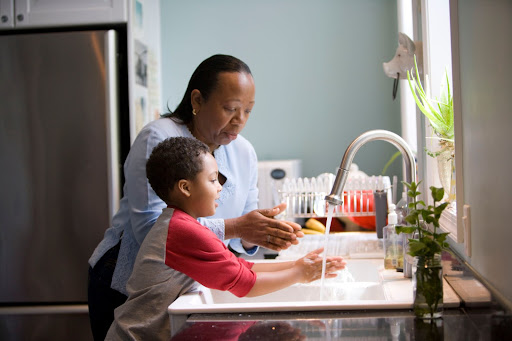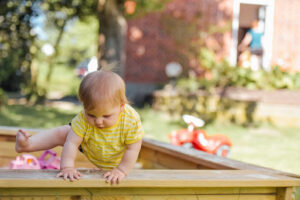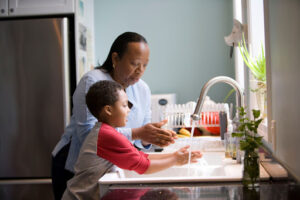
Thanks to a grant from the U.S. Department of Housing and Urban Development, BBF has been helping to raise awareness about lead exposure alongside the Vermont Housing & Conservation Board, Vermont Department of Health, and the Vermont Child Health Improvement Program (VCHIP). In a previous blog post, we shared how important it is for all young children to get their blood tested for lead at age 1 and 2.
If you have young children living in your household or visiting your home, it’s also important to test your drinking water, paint, and soil around your house. This testing should be done by a certified lead professional. The Vermont Department of Health provides this list of certified lead professionals, their contact information, and what questions homeowners should ask.
If you rent your home and the building was built before 1978, your landlord or property manager is required by Vermont law to make sure that lead paint is in good condition so that it does not cause lead poisoning.
Lead in Paint or Soil

If your home was built before 1978, it’s safe to assume that it contains lead paint. If the paint is well-covered under layers of newer paint, this may not be a problem, but any flaking, chipping, or crumbling paint can be dangerous. Lead contamination in soil most often occurs when lead-based paint flakes off from the outside of a building, or due to pollution from a nearby road.
If there is lead paint in your home, or lead in the soil around your house, here’s what you can do to reduce exposure for you and your children:
- Keep children away from areas where there is flaking or chipped paint.
- Regularly clean window sills, baseboards, and other hard surfaces using a spray bottle of all-purpose cleaner and wiping with paper towels. Afterwards, throw away the used paper towels in a plastic bag and tie it securely closed.
- Regularly clean hard floors with a wet mop, using a three-bucket system: one bucket with all-purpose cleaner mixed with water, a second bucket with clean rinse water, and a third bucket to wring out the excess rinse water.
- Regularly vacuum carpets and upholstery using a vacuum with a HEPA filter. Most stores that carry home appliances also sell HEPA filters, or you can order them online.
- Remove shoes before entering your house (to avoid tracking in dirt that may contain lead).
- For lead-contaminated soil, don’t let children play close to the foundation of the building, where lead levels may be highest if coming from flaking exterior paint. Plant grass and shrubs or put down a barrier like mulch to cover the soil, and consider building a sandbox filled with clean sand for children to play in.
- Have your children wash their hands and face often, especially before eating.
- Do not remodel, renovate, or repair without learning about lead‐safe practices. This includes replacing windows or repainting your home. The Vermont Department of Health shares a Don’t Spread Lead guide for homeowners working on smaller projects, such as repainting a room in a house with lead-based paint.
Sometimes abatement may be needed, which means the professional removal of lead-based paint and lead-contaminated dust, the permanent containment or encapsulation of lead-based paint, the replacement of lead-painted surfaces or fixtures, and the removal or covering of lead-contaminated soil. A lead risk assessment will show whether an abatement is needed, and the Vermont Department of Health is available to help homeowners understand the abatement process.
Lead in Drinking Water

The Vermont Department of Health recommends testing your well or spring for lead every five years. You can test your water for lead for $20 from the Vermont Department of Health, or order a kit from another certified laboratory.
You can’t see, taste, or smell lead, but it can occur in public and private drinking water systems, well components, and household plumbing. If lead is found in your drinking water, here’s how the U.S. Department of Housing and Urban Development (HUD) recommends protecting yourself and your family:
- Use cold water for cooking and install a water filter that’s certified to remove lead.
- Run water for 30 seconds to two minutes before drinking it, especially if you have not used your water for a few hours.
- Regularly clean the screen in your faucet (also known as an aerator).
- Remember that boiling water doesn’t remove lead.
Lead in Toys, Candy, and Other Products
Some toys, candy, jewelry, craft supplies, and home remedies can contain lead, especially if they were imported from outside the United States. Check the Consumer Product Safety Commission for their latest recalls.
More Resources
- Lead-Safe Cleaning brochure (Vermont Department of Health)
- Lead in Paint (Vermont Department of Health)
- Lead in Soil (Vermont Department of Health)
- Lead in Drinking Water (Vermont Department of Health)
- Safe and Healthy Home guide (U.S. Department of Housing and Urban Development)
- Protect your family from lead (Environmental Protection Agency)
- The HUD brochure Protect Your Family From Lead in Your Home is available in English, Spanish, French, Russian, Polish, Chinese, Korean, Vietnamese, Tagalog, Somali, and Arabic.


